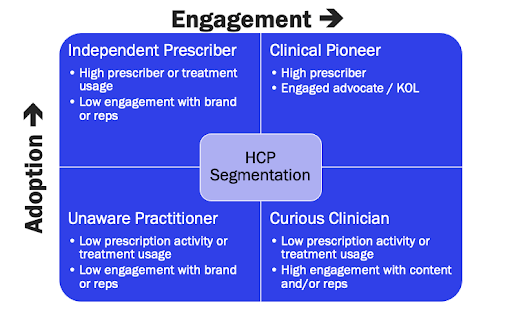Three Personalization Tips Life Sciences Marketers Can Use

Every industry and vertical has specialized data types and segments to meet its needs and serve its customers. That’s especially true of the life sciences sector. To help digital marketers working within the life sciences sector better connect, engage, and convert healthcare practitioners, we’ve put together this guide to personalized digital experiences for the life sciences industry.
How life sciences marketers can segment to personalize

The table below displays an example of different types of audiences life sciences marketers may target in their personalization efforts. These segments can be created from a single data point — say, an HCP persona assigned to a contact — or by a mixture of data for even finer targeting.
In each case, where a buyer doesn’t fall into a particular segment — whether because of a lack of data, or because they don’t align exactly to a segment — the fallback acts as a default. These are the individuals you don’t have any data on and therefore don’t fall into any segment.
| Segment type | By HCP persona | By specialty area | By patient risk population | By adoption ladder | By field rep territory | By HCP engagement level |
| Segment 1 | Doctor – specialist | Rheumatology | High | Advocate / KOL prescriber | West | High |
| Segment 2 | Doctor – GP | Immunology | Medium | Frequent prescriber | South | Medium |
| Segment 3 | Nurse | Gastroenterology | Low | Infrequent prescriber | East | Low |
| Segment 4 | Physician Assistant | Endocrinology | Unsure | Non-prescriber | North | Never engaged |
How effective segmentation and personalization can improve HCP engagement

While HCPs are becoming increasingly comfortable engaging with life sciences brands in digital settings, they still don’t want to be bombarded with information. Indeed, The State of HCP Customer Experience in Pharma reveals that 80% of HCPs feel that any more than two interactions, across all types of content, per month is too much. Because of this, each interaction a life sciences company has with an HCP needs to be meaningful and relevant.
One way life science marketers can ensure they are meaningfully engaging with HCPs is through segmentation. Through segmentation, digital marketers in this field can personalize outreach and as a result:
-
- Deliver more relevant content. When marketers understand the different needs and interests of target audiences, they can create content that is more likely to be relevant and engaging. This can lead to higher levels of engagement with information.
- Target information and outreach more effectively. Segmentation can also help marketers target outreach more effectively. For example, if a marketer knows a particular HCP is interested in a certain topic, they can send them targeted content. This can increase the likelihood of the HCP opening and reading the content.
- Develop and strengthen ongoing relationships with HCPs. Segmentation can also be used to personalize the customer journey. This means creating a unique and tailored experience for each HCP, from the moment they first interact with a life sciences company until they become a loyal customer. This can lead to higher levels of satisfaction and loyalty.
Now let’s look at a few ideas that you can try out to personalize your own life science marketing efforts.
Idea 1: Create and promote the right events with segments for HCP personas and roles
| Segment name | Example data to build segment | Their needs | Example of relevant event |
| Doctor – Specialist | Job function contains Medical Doctor, MD Physician or DO
Title contains reference to speciality, i.e., Rheumatologist, Immunologist, Endocrinologist, Gastroenterologists |
Keep up-to-date on treatments and medical technologies or products related to field of expertise.
Latest research in field of practice. |
Round table discussion with leaders in the specific field of medicine discussing latest discoveries in the field.
Demo of new medical technology – offering certification for attendance. |
| Doctor – GP | Job function contains Medical Doctor, MD Physician or DO
Title contains General Practitioner, Family Practice |
Keep up-to-date on new medications available to prescribe.
Updates on innovations/procedures in patient care. |
Webinar covering specific medication with ability for attendee chat or breakout rooms so attendees can share ideas and discuss the content. |
| Nurse | Job function contains nurse
Title contains RN, LPN, LVN, NP APRN |
Updates in patient care and procedures. | Webinar featuring updates in area of patient care that is focused on nurses and different aspects that effect nurses
Opportunity to receive certification and continuing education credits. |
| Physician Assistant | Job function contains Physician’s Assistant
Title contains PA |
Keep up-to-date on new medications available.
Updates on innovations/procedures in patient care. |
Webinar covering specific medication with ability for attendee chat or breakout rooms so attendees can share ideas and discuss content.
Opportunity to receive certification and continuing education credits. |
| Fallback | (No segment) | Identify prospect | High-level general trends webinar. |
Segmenting the audience by different roles, such as physicians, specialists, nurses or pharmacists provides an opportunity to address each segment’s needs. For example, specialists such as rheumatologists or cardiologists will have different challenges and interests compared to a general practitioner, nurse or pharmacist. By segmenting, you can develop events that suit the needs of each persona and connect with them in a way that helps them, rather than simply add to the digital noise.
No matter what segment you are creating an event for, strongly consider offering certification or CPE credits. Keeping on top of the latest developments in their field is a high priority for HCPs. The 2024 Life Sciences Digital Engagement Benchmarks Report confirms the value HCPs place in earning certification through digital events, with a 54% year-over-year increase in the number of digital certifications per attendees issued by life sciences companies in 2023.
Idea 2: Curate relevant content for specialists and practice area segments
Take segmentation a step further by creating a content hub or resource center dedicated to specialists and practice area segments. This can be done first by using keywords in titles to target specialties. Then, using related topics of interest, you can identify specific illnesses each segment will likely treat so you can tailor messaging and content to address specific needs for that area.
This could include sharing the latest relevant research and case reports from experts in their given practice area. You might also consider using epidemiology to identify where mobility is high, and then targeting proactively by region or geography.
| Segment name | Example data to build segment | Their needs | Examples of personalized content offer |
| Rheumatology | Job function contains Medical Doctor, MD physician or DO
Title contains reference to rheumatology |
Keep up-to-date on treatments and medical technologies or products related to field of rheumatology.
Latest research in field of rheumatology. |
Invite to webinar summarizing the latest research and treatments innovations in this area.
Content hub hosting all recent content relevant to this speciality. |
| Immunology | Job function contains Medical Doctor, MD physician or DO
Title contains reference to immunology |
Keep up-to-date on new medications available to prescribe.
Updates on innovations/procedures in patient care. |
Invite to webinar summarizing the latest research and treatments innovations in this area.
Content hub hosting all recent content relevant to this speciality. |
| Gastroenterology | Job function contains Medical Doctor, MD physician or DO
Title contains reference to gastroenterology |
Updates in patient care and procedures. | Invite to webinar summarizing the latest research and treatments innovations in this area.
Content hub hosting all recent content relevant to this speciality. |
| Endocrinology | Job function contains Medical Doctor, MD physician or DO
Title contains reference to endocrinology |
Keep up-to-date on new medications available.
Updates on innovations/procedures in patient care. |
Invite to webinar summarizing the latest research and treatments innovations in this area.
Content hub hosting all recent content relevant to this speciality. |
| Fallback | (no segment) | Identify prospect | High-level general trends and research webinar. |
Idea 3: Identify and create advocates and prescribers by building segments based on prescription activity and engagement level
Advocacy plays a very important role for most companies. This is possibly even more so when it comes to advocacy within the life sciences space. HCPs trust the opinions of their peers, so identifying those HCPs that are primed for advocacy is essential.
This can be done by identifying HCPs who are frequent prescribers, but are not highly engaged with your brand, then target them with opportunities to become advocates or key opinion leaders.
As an example, you might choose to create new segments and sub-personas based on two of the areas listed in the table at the start of this post:
-
- By adoption ladder — separating out HCPs that prescribe or use treatment options at a high frequency; and
- By HCP engagement level — segmenting HCPs by how often they access, view, download or otherwise engage with your content, events and online experiences.
This segmentation could then be used to create four different target audience types, as shown in the following image.

A key benefit of this approach it that enables careful thinking about the core goal you might have for each more detailed segment. This then makes it easier to decide on which personalized offer is both going to be relevant to them and to help you achieve that goal.
| Segment name | Example data to build segment | Your goal | Example of relevant offer |
| Clinical Pioneer | Adoption = High Engagement = High |
Maintain high engagement.
Maintain and strengthen relationship as advocate / KOL. |
Invitation to speak / present at an event.
Invitation to attend prestigious event at interesting location/region (e.g., invite to European conference for US KOL). |
| Independent Prescriber | Adoption = High Engagement = Low |
Develop engagement.
Try to convert to advocate / KOL. |
Invitation to speak / present at an event.
Invitation to attend interesting conference. Personalized outreach falling for case reports / product improvement suggestions. |
| Curious Clinician | Adoption = Low Engagement = High |
Increase adoption / usage / prescribing activity. | invitation to live webinar on the latest research / clinician reports covering treatment with product / device. |
| Unaware Practitioner | Adoption = Low Engagement = Low |
Increase or commence usage / prescribing activity.
Build engagement. |
Invitation to high-level webinar on latest treatment options and innovations |
| Fallback | (No segment) | Identify contact through digital engagement | Sign up to our research events. |
How ON24 helps leading life sciences firms to more effectively engage HCPs
ON24 helps life sciences marketers to drive stronger results from their HCP engagement activities. From live and on-demand virtual events, to personalized content hubs and rich analytics capabilities, ON24 provides you with the tools you need within a single platform.
Learn more about how ON24 can achieve your HCP engagement goals, or see how ON24 helped UBC scale its regional webinars targeted at rheumatologists.
